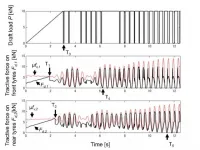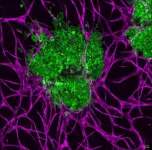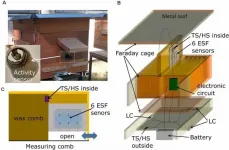INFORMATION:
References
(1) Simon T-P et al. Prognostic Value of Bioactive Adrenomedullin in Critically Ill Patients with COVID-19 in Germany: An Observational Cohort Study. Journal of Clinical Medicine. 2021, 10, 1667. https://doi.org/10.3390/jcm10081667
(2) Mebazaa A et al. Circulating adrenomedullin estimates survival and reversibility of organ failure in sepsis: the prospective observational multinational Adrenomedullin and Outcome in Sepsis and Septic Shock-1 (AdrenOSS-1) study. Critical care. Dec 21 2018;22(1):354.
(3) Caironi P et al. Circulating Biologically Active Adrenomedullin (bio-ADM) Predicts Hemodynamic Support Requirement and Mortality During Sepsis. Chest. Aug 2017;152(2):312-320.
(4) Ter Maaten JM et al. Bio-adrenomedullin as a marker of congestion in patients with new-onset and worsening heart failure. European Journal of Heart Failure. Jun 2019;21(6):732-743.
(5) Tolppanen H et al. Adrenomedullin: a marker of impaired hemodynamics, organ dysfunction, and poor prognosis in cardiogenic shock. Annals of Intensive Care. Dec 2017;7(1):6.
About Uniklinik RWTH Aachen
The Uniklinik RWTH Aachen is a supramaximal care provider that combines patient-oriented medicine and nursing, teaching and research at an international level. With 36 specialist clinics, 28 institutes and five interdisciplinary units, the University Hospital covers the entire medical spectrum. Excellently qualified teams of doctors, nurses and scientists are competently committed to the health of the patients. The bundling of patient care, research and teaching in one central building offers the best conditions for intensive interdisciplinary exchange and close clinical and scientific networking. Around 8.000 employees provide patient-oriented medicine and care according to recognized quality standards. With 1.400 beds, the University Hospital treats around 50.000 inpatient and 200.000 outpatient cases per year.
About SphingoTec
SphingoTec GmbH ("SphingoTec"; Hennigsdorf near Berlin, Germany) develops and markets innovative in vitro diagnostic (IVD) tests for novel and proprietary biomarkers for the diagnosis, prediction and monitoring of acute medical conditions. SphingoTec's proprietary biomarker portfolio includes bioactive Adrenomedullin (bio-ADM), a unique biomarker for real-time assessment of endothelial function in conditions like sepsis or congestive heart failure, Proenkephalin (penKid), a unique biomarker for real-time assessment of kidney function, and Dipeptidyl Peptidase 3 (DPP3), a unique biomarker for cardiac depression. IVD tests for SphingoTec's proprietary biomarkers are made available as sphingotest® microtiter plate tests as well as point-of-care tests on the Nexus IB10 immunoassay platform.SphingoTec's subsidiary Nexus Dx Inc. (San Diego, CA, USA) produces the tests alongside a broad menu of established and commonly used tests for acute and critical care.
About bio-ADM
IB10 sphingotest® bio-ADM® is a rapid point-of-care (POC) immunoassay for the in vitro quantitative determination of bioactive Adrenomedullin (bio-ADM), a hormone maintaining endothelial function. The endothelium contributes to blood pressure and separates blood from the surrounding tissue. Elevated blood levels of bio-ADM predict blood pressure break down and leaky vessels resulting in oedema. Imbalanced endothelial function is the major cause of shock ultimately resulting in organ dysfunction and death. Early identification of an imbalance in endothelial function allows guidance of vasopressor and diuretic therapy in critically ill patients to improve outcomes.
Endothelial function biomarker bio-ADM for risk stratification and management of COVID-19 patients
Elevated bio-ADM levels indicate disease severity and predict the need for extracorporeal organ assist in COVID-19 patients
2021-05-04
(Press-News.org) Aachen, Germany and Hennigsdorf/Berlin, Germany, May 4, 2021 - German University Hospital Uniklinik RWTH Aachen ("Uniklinik RWTH Aachen") and diagnostics company SphingoTec GmbH ("SphingoTec") today announced that the endothelial function biomarker bio-ADM aids in the early risk stratification and management of patients suffering from severe COVID-19, in need for escalated intensive care treatment (1). A team lead by the clinical researchers at Uniklinik RWTH Aachen has shown that high bio-ADM levels indicate the severity of the acute respiratory distress syndrome (ARDS), the subsequent need for organ support, and poor outcomes in severely ill COVID-19 patients. Bioactive Adrenomedullin (bio-ADM) is a hormone regulating endothelial function and has been previously validated in over 35.000 patients with diseases where endothelial dysfunction plays a key role, such as sepsis, septic shock, cardiogenic shock, and acute heart failure.
According to the recently published data (1), high bio-ADM levels predict a severe course of COVID-19 infection at admission and identify patients with deteriorating lung function at high risk to develop severe ARDS. Furthermore, the data demonstrate that high bio-ADM levels identify those patients in need of extracorporeal organ assist, such as mechanical ventilation, veno-venous extracorporeal membrane oxygenation (ECMO), renal replacement therapy (RRT).
Prof. Gernot Marx, (Director of the Department of Operative Intensive Care Medicine and Intermediate Care at Uniklinik RWTH Aachen) commented, "In the management of COVID-19 patients there is a high need for early risk stratification biomarkers that allows us to allocate resources and timely plan for therapy escalation. Endothelial dysfunction is a central mechanism in the pathophysiology of many critical care conditions, including COVID-19. The information provided by the bio-ADM measurements has convinced us to include it in our clinical routine measurements. "
These findings confirm and extend previous studies in critical care patients where bio-ADM indicates severe complications in sepsis (2,3), acute heart failure (4), and cardiogenic shock (5). High bio-ADM levels indicate severe hypotension, edema formation, ionotropic/vasopressor use, need for organ support, such as mechanical ventilation, and subsequent organ failure. Being a dynamic biomarker, low or decreasing bio-ADM blood levels indicate improved outcomes (3).
Dr. Andreas Bergmann, CEO and founder of SphingoTec, said, "By monitoring the endothelial dysfunction early in COVID-19 patients, clinicians can timely identify those patients with an unfavorable disease progression. To further support the management of critically ill patients, we have made available the assay for bioactive Adrenomedullin as a rapid near-patient test."
The CE marked point of care assay for measuring bio-ADM levels is commercialized under the brand name IB10 sphingotest® bio-ADM®. The rapid test runs on SphingoTec`s automated Nexus IB10 point-of-care platform and quantitatively measures levels of bio-ADM directly in blood samples and delivers results after 20 minutes.
ELSE PRESS RELEASES FROM THIS DATE:
Staying down on the farm
2021-05-04
Tokyo, Japan - Researchers at Tokyo University of Agriculture and Technology (TUAT) modeled the dynamic instability--the so-called "power hop"--that can cause uncontrollable bouncing and damage tractors when they plow dry ground. The team found that self-excited oscillations can arise when the tractor pushes against the ground.
Plowing a field on a tractor may seem like a serene occupation, but sudden vibrations can grow unexpectedly and threaten to topple you under certain conditions. The problem is that in nonlinear systems with coupled components, as with a mechanical tractor, ...
Closing in on state-of-the-art semiconductor solar cells
2021-05-04
A synthetic approach that improves absorber layers in perovskite solar cells could help them achieve their full potential and draw closer to the performance of leading gallium arsenide devices.
Solar cells that rely on perovskite thin films to capture sunlight are the fastest growing photovoltaic technology. Cheaper and easier to manufacture and incorporate into devices than conventional semiconductors, lead halide perovskites also effectively absorb visible light and display long charge carrier diffusion lengths -- an indicator of their ability to maintain light-induced electrons and holes separation and facilitate charge transport.
Performance ...
Aryl hydrocarbon receptor suppresses immunity to oral cancer through immune checkpoint regulation
2021-05-04
A new Boston University School of Public Health (BUSPH) study has identified for the first time how the aryl hydrocarbon receptor (AhR), an environmental chemical receptor, drives immunosuppression in oral squamous cell carcinoma (OSCC)--and that its removal from malignant cells can result in tumor rejection.
Published in the journal Proceedings of the National Academy of Sciences, the study findings provide new insight into the biology of cancer immunosuppression, and identify a new target for cancer immunotherapy treatment.
Immune checkpoint inhibitors (immunotherapy drugs) are some of the most important treatments that have emerged for treating many cancers, including OSCC. Targeting immune checkpoint molecules such as PD-1, ...
Polarization and mobilization on social media affect infection figures
2021-05-04
Measures to contain the Corona pandemic are the subject of politically charged debate and tend to polarize segments of the population. Those who support the measures motivate their acquaintances to follow the rules, while those who oppose them call for resistance in social media. But how exactly do politicization and social mobilization affect the incidence of infection? Researchers at the Max Planck Institute for Human Development have examined this question using the USA as an example. Their findings were published in Applied Network Science.
Limit crowds, keep a safe distance, and wear masks. Such non-pharmaceutical ...
The micro-environment of breast cancer in three dimensions
2021-05-04
Cancerous tumors thrive on blood, extending their roots deep into the fabric of the tissue of their host. They alter the genetics of surrounding cells and evolve to avoid the protective attacks of immune cells. Now, Penn State researchers have developed a way to study the relationship between solid, difficult-to-treat tumors and the microenvironment they create to support their growth.
The method has the potential to act as a testbed for drugs and other anticancer treatments, according to Ibrahim T. Ozbolat, associate professor of engineering science and mechanics and biomedical engineering, who led the research. The details of the approach were published in Advanced Biology.
Using ...
Snakeskin can inspire to safer buildings
2021-05-04
Despite human inventiveness and ingenuity, we still lag far behind the elegant and efficient solutions forged by nature over millions of years of evolution.
This also applies for buildings, where animals and plants, have developed extremely effective digging methods, for example, that are far more energy-efficient than modern tunnelling machines, and even self-repairing foundations that are unusually resistant to erosion and earthquakes (yep, we're talking about roots here).
Researchers from all over the world are therefore seeking inspiration in nature to develop the buildings of the future, and researchers from Aarhus University ...
The secret life of bee signals can communicate colony health
2021-05-04
Honeybees have a complex communication system. Between buzzes and body movements, they can direct hive mates to food sources, signal danger, and prepare for swarming - all indicators of colony health. And now, researchers are listening in.
Scientists based in Germany - with collaborators in China and Norway - have developed a way to monitor the electrostatic signals that bees give off. Basically, their wax-covered bodies charge up with electrostatic energy due to friction when flying, similar to how rubbing your hair can make it stand on end. That energy then gets emitted during communications.
"We were thrilled by the ...
Fertility apps with hundreds of millions of users collect and share excessive information
2021-05-04
The majority of top-rated fertility apps collect and even share intimate data without the users' knowledge or permission, a collaborative study by Newcastle University and Umea University has found.
Researchers are now calling for a tightening of the categorisation of these apps by platforms to protect women from intimate and deeply personal information being exploited and sold.
For hundreds of millions of women fertility tracking applications offer an affordable solution when trying to conceive or manage their pregnancy. But as this technology grows in popularity, experts have revealed that most of the top-rated fertility apps collect and share sensitive ...
Using personalized medicine to avoid resistance to leukemia treatment
2021-05-04
T-cell acute lymphoblastic leukemia (T-ALL) is a very aggressive type of blood cancer. It is relatively rare but still draws a lot of attention as it mostly develops in children under the age of 20. The standard treatment for T-ALL involves heavy chemotherapy procedures, which result in favorable outcomes with an overall survival of 75% after 5 years.
However, some patients do not respond to this treatment, or they only respond for a short period, after which the disease grows back. These patients therefore need alternative therapies.
Researchers from the Faculty of Health and Medical Sciences, University of Copenhagen, have now identified a combination treatment, which could potentially benefit patients ...
Insights from color-blind octopus help fight human sight loss
2021-05-04
University of Bristol research into octopus vision has led to a quick and easy test that helps optometrists identify people who are at greater risk of macular degeneration, the leading cause of incurable sight loss.
The basis for this breakthrough was published in the latest issue of the Journal of Experimental Biology and describes new technology developed by lead researcher, Professor Shelby Temple, to measure how well octopus- which are colour-blind - could detect polarized light, an aspect of light that humans can't readily see. Using this novel technology, the research team showed that octopus have the most sensitive polarization vision system of any animal tested to date. Subsequent research ...
LAST 30 PRESS RELEASES:
PolyU develops new human-safe magnetorheological fibres, leading innovations in smart wearable textiles
Rice establishes Global Brain Economy Initiative in Davos, aligned with new report on brain health and AI
Quantum error correction with logical qubits
Nutrient-stimulated hormone-based therapies: A new frontier in the prevention and management of MASH-associated hepatocellular carcinoma
Trauma or toxic? A deep dive into the impact of stress on kids' health
Turning industrial exhaust into useful materials with a new electrode
ORNL to partner with Type One Energy, UT on world-class facility to validate next-gen fusion
New journal section tackles AI, ethics, and digital health communication
Jeonbuk National University researchers develop novel dual-chemical looping method for efficient ammonia synthesis
New study sheds light on stroke recovery via exercise-induced migration of mitochondria
SEOULTECH researchers develop sodium-based next-generation smart electrochromic windows
Data-driven analysis reveals three archetypes of armed conflicts
Heart disease, stroke deaths down, yet still kill more in US than any other cause
Light switches made of ultra-thin semiconductor layers
Creative talent: has AI knocked humans out?
Sculpting complex, 3D nanostructures with a focused ion beam
A year after undermining Bredt’s rule, UCLA scientists have made cage-shaped, double-bonded molecules that defy expectations
Human activities drive global dryland greening
PeroCycle announces new appointments as it builds a world-class board for meaningful climate impact
Magnetic avalanches power solar flares
LeapSpace goes live: the Research-Grade AI-Assisted Workspace built on trusted science
DNA tests reveal mysterious beluga family trees
Strategic sex: Alaska’s beluga whales swap mates for long-term survival
How early cell membranes may have shaped the origins of life
Cannabis legalization is driving increases in marijuana use among U.S. adults with historically lower consumption rates
Multifunctional dipoles enabling enhanced ionic and electronic transport for high‑energy batteries
Triboelectric nanogenerators for future space missions
Advancing energy development with MBene: Chemical mechanism, AI, and applications in energy storage and harvesting
Heteroatom‑coordinated Fe–N4 catalysts for enhanced oxygen reduction in alkaline seawater zinc‑air batteries
Meta-device for precision lateral displacement sensing
[Press-News.org] Endothelial function biomarker bio-ADM for risk stratification and management of COVID-19 patientsElevated bio-ADM levels indicate disease severity and predict the need for extracorporeal organ assist in COVID-19 patients



